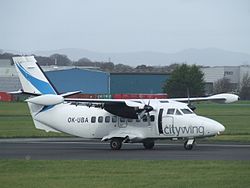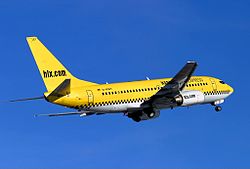Virtual airline (corporate)
A virtual airline is a transport company active in the aviation industry that does not handle all of the typical business areas itself and has outsourced tasks to external service providers . These include companies that do not have an Air Operator Certificate (AOC), but market flights and have them carried out under their own branding by renting aircraft and crews from other airlines . This term also includes airlines that have specialized, for example, in ACMI rentals and have thus been able to thin out their corporate structure . Corresponding airlines have an AOC, but operate their machines for other companies and usually do not appear under their own brand.
For example, the logistics group Deutsche Post DHL Group , which does not have an AOC itself, describes itself as a virtual airline because the Group's own cargo airlines appear uniformly under its corporate identity and work exclusively for the parent company. The various DHL airlines have their own operating certificates (AOC), but are also virtual airlines because they only have the core task of "flying". All other business areas that a traditional airline has to cover in addition to operations (e.g. marketing , advertising , acquisition , ticket sales , route network planning, setting freight rates or flight prices) are omitted from the DHL subsidiaries or are taken over by the parent company.
Virtual airline without AOC

The business model of a virtual airline without AOC represents a further development of the classic charter flight concept. As there, a sales company , which determines the route, sells the tickets and specifies the range of services on board, instructs an airline to carry out the actual transport service. In the case of virtual airlines, the contract flights, in contrast to charter traffic, do not take place in the branding of the partner airline, but in the corporate identity of the sales company. From the outside it is no longer recognizable that the flights are being operated by another company. For the passengers, the “ticket seller” appears as an airline, although he is not this under aviation law . In addition, a virtual airline does not have an ICAO code due to the lack of an operator certificate . The operation takes place with flight numbers of the partner company.
A virtual airline without AOC is absolutely dependent on the cooperation with one or more partner airlines and thus becomes dependent. However, this business model offers several advantages over founding a traditional airline:
- Flight operations can begin promptly because you do not need to apply for your own AOC.
- A smaller amount of start-up capital is required to set up a company.
- The sales company can concentrate on its core competencies and completely outsource flight operations.
- The commissioned airline undertakes to carry out operational operations in wet lease and is also responsible for the maintenance and insurance of the machines used. If an aircraft breaks down, it has to provide a replacement.
- The virtual company only needs a small number of its own employees. The commissioned airline provides the crews within the framework of the leasing agreement.
- By initially only renting aircraft in blocks , the profitability of the operation or the need for a route with a low investment risk can be tested. The virtual company is therefore not under the pressure of having to continuously utilize aircraft or crews.
- The virtual airline can adapt its capacities to requirements at short notice by renting additional aircraft and crews or not extending existing ACMI contracts.
The first virtual airlines emerged in the 1990s, but their number only increased significantly after the turn of the millennium . In the meantime, established airlines and their holdings also use this business model, in particular to set up low-cost airlines . The International Airlines Group , for example, owns a virtual airline called Level , which is operated by its sister company Iberia . Some of the virtual companies receive their own operating certificates after they start operations and are thus converted into traditional airlines , as in the case of the Italian Ernest Airlines .
Virtual airlines without AOC are / were among others:
- Air Åland
- Air Canada Tango
- Air Croatia
- Air Djibouti (2015)
- Air Norway
- Air Timor
- Amazon Prime Air
- Anadolujet
- BRA Braathens Regional Airlines
- Buta Airways
- City Star Airlines
- Citywing
- Denim Airways
- Gotlandsflyg
- Greenland Express
- Höga Kusten Flyg
- Hooters Air
- Iceland Express
- Kosova Airlines
- Kullaflyg
- Level
- Lübeck Air
- Manx2
- Melilla Airlines
- Namibia flyafrica
- Nordica
- Rhein-Neckar Air
- song
- Svenska Direktflyg
- Sverigeflyg
- Transaer Cologne
- Up
- Vildanden
- Wingo
Virtual airline with AOC

Corresponding companies have an operator's certificate and are therefore airlines under aviation law. Your additional classification as a virtual airline is therefore based exclusively on the corporate structure or on the outsourcing of business areas that an air transport company traditionally covers itself.
Under the Airline Deregulation Act , the larger US scheduled airlines expanded their national route networks by buying up regional airlines or cooperating with them. In the 1980s, the aviation groups developed umbrella brands such as American Eagle , Continental Connection , Delta Connection , Northwest Airlink , United Express and USAir Express , under which the regional partners belonging to a group of companies continued to operate. At the same time, these companies ceded numerous business tasks that they had previously had to perform themselves to the larger scheduled airlines. For example, United Airlines takes on the marketing, ticket sales and route planning for all cooperation partners who use the United Express brand in franchising . It also specifies the number of flight frequencies and the ticket prices. The regional airlines leaving only the core task of "flying" where and its operations with United Airlines - flight numbers takes place. In Germany, a similar model was created in 1996 with the Lufthansa team .
A comparable development began in the 1980s in cargo air traffic, when logistics groups such as DHL , Federal Express or United Parcel Service founded their own airlines or bought up and renamed existing companies such as Flying Tigers . The German Post DHL Group owns the DHL Aero Expreso , DHL Air UK , EAT Leipzig and SNAS / DHL several airlines, the uniform of the parent company appearing in the corporate identity and therefore can not be recognized as an individual company. These subsidiaries do not need their own sales structures because they only work for the logistics group and their flight operations are coordinated by DHL Aviation .
In the late 1970s emerged airlines like United Air Carriers whose core business is the leasing of aircraft in Dry and wet-lease was. In addition, some of these companies also operated their own flights. The business model was adopted in a modified form from the early 1990s onwards by airlines that specialize exclusively in ACMI rentals (Aircraft, Crew, Maintenance and Insurance). Corresponding companies such as Atlas Air operate their fleets in wet leases for other airlines or logistics groups and assign tasks that an air transport company traditionally does itself to the customer. For example, the tenant is responsible for scheduling and utilizing the machines. The ACMI company only focuses on the actual operation, which usually takes place in the brand identity and under the flight numbers of the lessee. If the lessee is a company without an AOC, the ACMI company must use its ICAO code or its own flight numbers for the contract flights under aviation law.
As a rule, an airline carries out its own operations. However, there are rare cases in which this core task is completely outsourced to external companies and an airline only takes on the marketing of its own flights. It takes up the business model, which is implemented in an identical way by a virtual airline without AOC. The only difference is that you can use your own flight numbers. For example, the low-cost airline Hapag-Lloyd Express had an operator's license, but was only active as a sales company. It commissioned the sister company Hapag-Lloyd Flug and Germania to carry out its flights . The British Peach Air had also completely outsourced its flight operations and only used machines rented in wet lease.
Due to their core business orientation, virtual airlines are / were among others:
- Air Atlanta Icelandic
- Air Wisconsin
- Astraeus Airlines
- Atlas Air
- Avion Express
- Chautauqua Airlines
- Denim Air ACMI
- DOT LT
- Envoy Air
- GetJet Airlines
- Global Supply Systems
- Go2Sky
- GoJet Airlines
- Hapag-Lloyd Express
- Hi Fly
- Piedmont Airlines (1993)
- PSA Airlines
- Regional jet
- Republic Airline
- SkyWest Airlines
- Southern Air
- Transwede Airways
- United Air Carriers
- Van Air Europe
Delimitations
-
Charter flight :
A customer, for example a tour operator or a freight forwarder , rents an aircraft with the crew or only partial capacities on board. The transport service takes place in the brand identity of the commissioned airline and under their flight numbers.
-
Umbrella brand :
Umbrella brands such as Delta Connection or United Express are not companies and therefore neither real nor virtual airlines. The sole proprietorships operating under an umbrella brand, on the other hand, can be viewed as virtual airlines if they have outsourced their own business areas to the contracting aviation group.
-
Aviation
alliance : In an alliance, an airline sells tickets or transport services under its own name to destinations that it does not serve itself. These flights are operated by an alliance partner in code sharing. All airlines in the alliance have an AOC.
See also
Individual evidence
- ^ Wilhelm Pompl: Air traffic: An economic and political introduction . Springer-Verlag, Berlin 2006, ISBN 978-3-540-32752-3 .
- ^ A b Axel Schulz: Basics of traffic in tourism: airlines, cruises, trains, buses and rental cars . Oldenbourg Verlag, Munich 2014, ISBN 978-3-486-72505-6 .
- ^ Deutsche Post DHL Group, Annual Report 2015 , accessed on December 16, 2017
- ^ Ch-Aviation, What is a virtual carrier? (in English), accessed January 1, 2018
- ^ A b Georg Williams, Svein Bråthen: Air Transport Provision in Remote Regions . Routledge, New York 2016, ISBN 978-1-315-56636-8 .
- ↑ James W. Brock: The Structure of American Industry, Thirteenth Edition . Waveland Press, Inc., Long Grove 2015, ISBN 978-1-4786-2732-6 .
- ↑ a b c Airliners.de, Outsourcing of flight operations: Problem or solution ?, March 30, 2016 , accessed on January 1, 2018